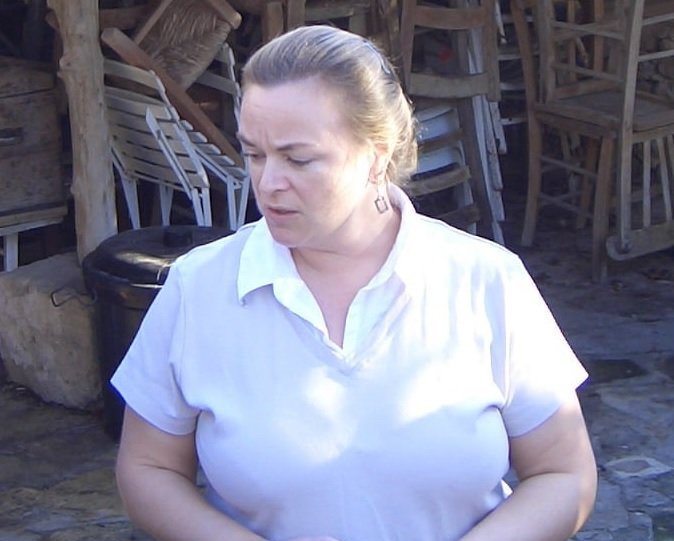The Archaeological Research Unit (ARU) of the University of Cyprus has issued an announcement mourning the loss of a valued member and colleague, Dr Carole McCartney. Dr McCartney had been a member of the ARU since 2005, when she joined the unit as an honorary research fellow. Since 2019, she had been working at the Archaeological Research Unit as a postdoctoral researcher, the ARU said.
Dr McCartney studied Archaeology at the University of Edinburgh and came to Cyprus for the first time in 1987, as a member of Eddie Peltenburg’s team excavating a number of Chalcolithic sites in the Paphos district. This initial visit was decisive in many respects, as Carole became attached to Cyprus both in her professional and her personal life; she met and married Pambos Michael and moved to Kissonerga, where they lived together with their two children, Katerina and Αimilios. She went on to receive her Masters in 1989 in Edinburgh and then her PhD in 1996 from the same University. The topic of her doctoral thesis was ‘The Analysis of Variability in Simple Core Technologies: Case Studies of Chipped Stone Technology in Post-PPN Assemblages from the Levant’.
The fact that over the last thirty years she worked as a lithic specialist for a number of excavations and surveys in Jordan, Syria, Egypt and of course Cyprus, means she was one of the best known and sought-after lithic experts in the Eastern Mediterranean region. She presented the results of her research in over 25 singled-authored and over 25 joint-authored papers, which have been published in scientific journals, conference proceedings and monographs.
Having studied the chipped stone industries of the region for so long, she was one of the first archaeologists to identify the early date and importance of the material from the Mylouthkia wells in Kissonerga, the lower strata of Kalavasos Tenta and the sites recorded during the Sydney Cyprus Survey Project. These finds pushed the limits of the Neolithic in Cyprus to the period known as the Pre-Pottery Neolithic B or PPNB of the Levant, thus opening a whole new chapter in the island’s prehistory. Her involvement with other projects showed that initial, pre-Neolithic visits to the island were even earlier, and that Akrotiri Aetokremnos is not a unicum. More recently, she was working on the material from the early Neolithic site excavated by Nikos Efstratiou in the Paphos forest at Roudias.
Carole initiated a project entitled ‘Elaborating Early Neolithic Cyprus Project’ in 2005. This international cooperation between the University of Cyprus, Cornell University in the USA and Trent University in Canada, undertook intensive survey in the margins of the pillow lavas, in order to record lithic scatters, as well as chert sources. Eventually, the main focus of the project turned to the excavation of Ayia Varvara Asprokremmos. The initial intuition was proven correct, and the excavations have unravelled one of the most important prehistoric sites on the island. Through the study of this rather unique and specialised site, Dr McCartney was able to re-consider the earliest phase of the Neolithic.
In 2016, she co-organised at the University of Cyprus, together with Prof. Vasiliki Kassianidou, Dr Laurence Astruc and Dr François Briois, the ‘8th PPN Chipped and Ground Stone Industries of the Near East Conference: Near Eastern Lithic technologies on the move. Interactions and Contexts in the Neolithic Traditions’, which was attended by a great number of specialists from all over the world. The proceedings have been published in the Studies in Mediterranean Archaeology Series of Astrom Editions.
Since 2019, she held a postdoctoral position at the University of Cyprus, working with Prof. Vasiliki Kassianidou, Dr Stella Demesticha, and Dr Dora Moutsiou, with Dr Daniella Bar Yosef and other colleagues from Israel and colleagues from the Cyprus University of Technology on a project coordinated by Prof. Phaedon Kyriakides and entitled ‘Delineating probable sea routes between Cyprus and its surrounding coastal areas at the start of the Holocene: a simulation approach’.
“We were fortunate that for personal reasons, Carole chose Cyprus to be her home since 1995, and even more fortunate that since 2005 she was officially affiliated with the University of Cyprus as an honorary research fellow,” the ARU said. Dr McCartney was one of the leading experts on Cypriot lithics on an international level, while her work was greatly admired and respected. With her passing she leaves a huge gap which will be hard to fill. Her work will keep her memory alive, and her name will continue to be mentioned in current and future scholarship, it added.
And the ARU concluded: “Carole was a wonderful person and colleague, a good and dear friend. She was patient with new colleagues and was eager to train the new generation of archaeologists studying in the Department of History and Archaeology of the University of Cyprus. All her colleagues at the ARU and indeed all the Cypriot archaeological community are finding it extremely hard to believe she is gone. Our thoughts are with her family.”







Click here to change your cookie preferences